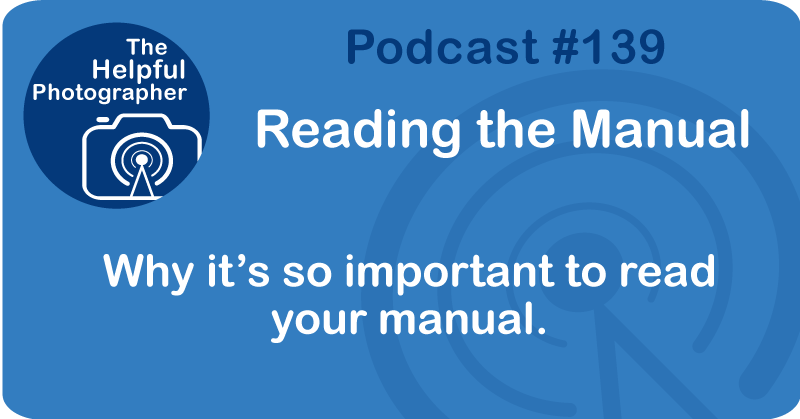Reading Your Manual #139

I recently heard someone who called themselves a professional photographer advise a group of amateur photographers that they shouldn't bother reading their camera manual, as it is too technical to understand and if you attempt to do so, it will drive you quote unquote crazy. Oh, did I just use a sound effect? I like that. I'm gonna have to do that more often. Okay, sorry, I digress. Although the gentleman who said thisdid emphasize the need to understand the functions of your camera, he thought the best way to do this was to simply learn it hands-on. And my response is, good luck with that. I think although it's incredibly important to get a ton of hands-on experience with your camera equipment, because after all, that is what we do when you join us on a New York City photo safari. But to say that it's useless to even review your manual is just flatly wrong. So why should you read your manual? Can't you just turn on your camera and press the shutter button and go? The answer is yes, absolutely you can. But remember, digital cameras are really small computers, and they have a ton more functionality than we did during film days. And every new generation seems to have more functions than the previous one. So if you are at least two generations away from your previous digital camera, you might want to at least glance through the manual. Also, many of the functions of your camera can be rather nuanced, and understanding how to tweak them can really help customize your camera for your particular needs, which will really help you as you try to get the best photos possible. For instance, here's a function that most people don't seem to know about. It's your minimum shutter speed setting in an auto ISO. Most cameras from prosumer on up have the ability to fine-tune this to the photographer. Most of you probably already know that in your Auto ISO Minimum Shutter Speed setting, you can set a static minimum shutter speed. In other words, a floor to the shutter speed that the camera will never go below unless you're shooting in manual mode. And many of you already know that you can set the shutter speed to Auto. In this case, the minimum shutter speed will be set against your focal length automatically. So if you have a zoom lens, the camera will change your shutter speed depending on where you have the zoom and based on the available light. How cool is that? But the problem is that that setting is for the average user. What if you have a hand tremor? This is where it gets fun, and this is what most people don't know. In the same auto setting, many cameras will allow you to customize it. In other words, you can tell the camera to bias the shutter speed a little bit faster or a little bit slower all of the time, and therefore address your particular capabilities or needs. Now that's crazy cool. This function has been available for over 10 years, and yet every last person I have shared this with didn't realize it was there, which tells me right off the bat they didn't read the manual. So why did this guy discourage people from reading the manual? The reason he gave was because they are highly technical documents translated into English from a foreign language, notably Japanese. And that's why it doesn't make sense to English speakers. But here's the problem. About 15 years ago, I met a white American man who worked for Nikon. You know, that small Japanese camera manufacturer. Them. Apparently, he was responsible for writing many of their manuals. And when I met him, I remember thinking, oh, now I understand why the manual is so difficult for people to understand. Right there, I had evidence that manuals are written by total photo nerds who are talking to other photo nerds. Since I understand the manuals, I guess that makes me a photo nerd. But to say that the manuals are impossible to understand because they're being translated is flatly wrong. And since I'm currently reading a manual for a new camera I just purchased, I decided to take a closer look at other manuals to see how they're shaping up. I looked at the Canon R5 Mark II, the Sony 7R Mark V, and the Nikon Z9 manuals. And guess what? I didn't see a problem. Both the Nikon and the Canon manuals were really easy reads, at least for me. The Sony manual definitely felt like it might have been translated from another language as it referred to the camera as the product. But it certainly wasn't gobbly-gook. And just so you know, English is a second language for me. And if I can understand this, come on. Look, I get it. I've had a lot of people tell me that they find the manual confusing, and I get that and the writer I met was definitely a contributing factor. And I do realize that I have a better handle on this stuff than most, but to discourage people from reading the manual is really photography malpractice. I definitely have my doubts about this guy's understanding of photography and his own camera. All this to say, read your manual. Do your best to get through it. Use a highlighter and sticky notes to keep track of important functions and to keep track of your customizations because you're going to want to know what you did to your camera when you have to do a factory reset. Ask me how I know that one. If you don't understand something, you can follow up on the internet, or send me an email. I'm not kidding. zim at nycphotosafari.com There are definitely some nuances in the manual that you will not get just by playing around with your camera and arbitrarily pushing buttons. And you know what? I paid a lot of money for my camera, and I definitely want to take advantage of its best functions. I hope that was helpful. Until next time, keep on shooting.











